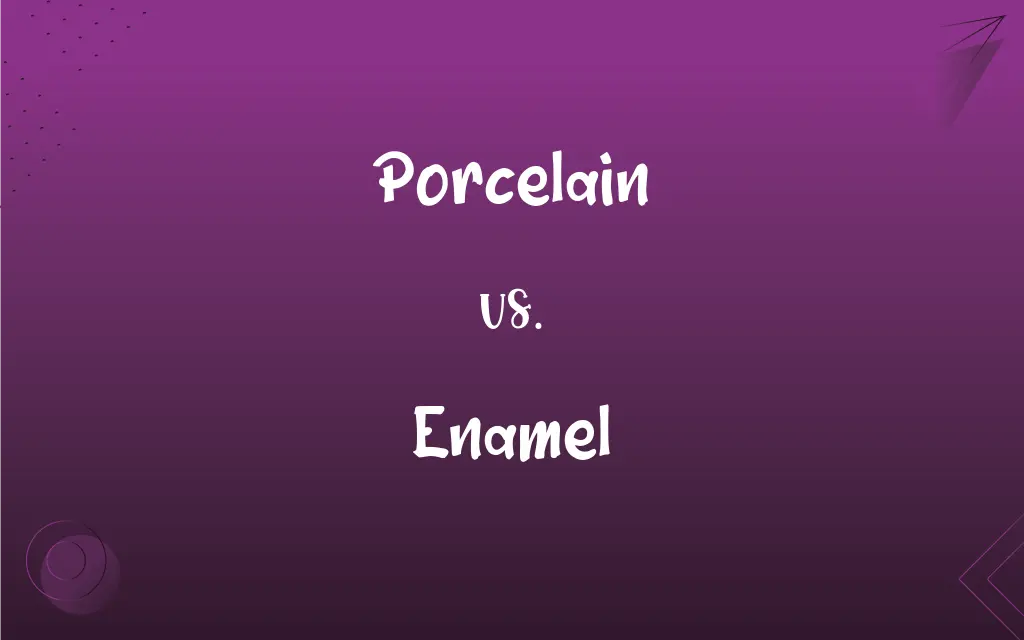Porcelain vs. Enamel: What's the Difference?
Edited by Aimie Carlson || By Janet White || Updated on October 7, 2023
Porcelain is a type of fine white or translucent ceramic, while enamel is a protective or decorative coating applied to metal, glass, or ceramic.

Key Differences
Porcelain is recognized for its delicate yet strong nature, crafted from clay by heating it to high temperatures, resulting in a hard, translucent ceramic. Enamel, conversely, is a form of molten glass, frequently fused to metals, ceramics, or even glass, serving as a protective or decorative layer.
The art of creating porcelain can be traced back to ancient China, where it was esteemed for its purity and translucent qualities, particularly in tableware and decorative objects. Enamel, on the other hand, is celebrated for its vibrant colors and glossy finish, which can adorn anything from jewelry to cookware.
When it comes to usage, porcelain often graces the tables as dinnerware, holds flowers as vases, or depicts art as figurines. Enamel finds its strength in versatility, from enamel-coated cast-iron cookware to decorative pins and vintage signage.
Porcelain requires a careful crafting process that includes using specific types of clay and high-temperature firings to achieve its characteristics. Enamel needs a substrate, like metal, to which the powdered glass can be applied and then fired, fusing the two together.
In summary, while both porcelain and enamel offer beauty and functionality in their own right, their core differences lie in composition, origins, and applications.
ADVERTISEMENT
Comparison Chart
Nature
Ceramic
Protective or decorative coating
Origin
Ancient China
Ancient cultures worldwide
Main Use
Tableware, vases, art
Cookware, jewelry, signage
Composition
Clay
Molten glass
Appearance
Translucent, often white
Glossy, can be various colors
ADVERTISEMENT
Porcelain and Enamel Definitions
Porcelain
A fine, white, or translucent ceramic.
She displayed a beautiful porcelain vase on the mantelpiece.
Enamel
A protective or decorative coating fused to metal, glass, or ceramics.
She wore a brooch with a beautiful blue enamel surface.
Porcelain
Ceramic ware made of this material.
The porcelain tea set was passed down through generations.
Enamel
The outer protective layer of a tooth.
He brushed his teeth regularly to protect the enamel.
Porcelain
Often associated with high-quality tableware.
Their dining table boasted exquisite porcelain dishes.
Enamel
A type of paint that dries to a hard, glossy finish.
They used enamel paint for the outdoor sign to ensure its longevity.
Porcelain
Material made by firing specific clays to high temperatures.
The artist molded the porcelain into intricate sculptures.
Enamel
Used to produce smooth, colorful designs on various objects.
Her vintage jewelry collection had several pieces with intricate enamel designs.
Porcelain
A hard, white, translucent ceramic made by firing a pure clay and then glazing it with variously colored fusible materials; china.
Enamel
A vitreous, usually opaque, protective or decorative coating baked on metal, glass, or ceramic ware.
Porcelain
An object made of this substance.
Enamel
An object having such a coating, as in a piece of cloisonné.
Porcelain
A hard white translucent ceramic, originally made by firing kaolin, quartz, and feldspar at high temperatures but now also inclusive of similar artificial materials; also often (figurative) such a material as a symbol of the fragility, elegance, etc. traditionally associated with porcelain goods.
Tableware and toilets are both made of porcelain.
Enamel
A coating that dries to a hard glossy finish
Nail enamel.
Porcelain
Syn of china: porcelain tableware.
He set the table with our porcelain and stemware.
Enamel
A paint that dries to a hard glossy finish.
Porcelain
Syn of kaolin: the kind of clay traditionally used in China to manufacture porcelain.
Enamel
(Anatomy) The hard, calcareous substance covering the exposed portion of a tooth.
Porcelain
An object made of porcelain, (particularly) art objects or items of tableware.
The museum has an extensive collection of rare Chinese porcelains.
Enamel
To coat, inlay, or decorate with enamel.
Porcelain
Syn of cowrie.
Enamel
To give a glossy or brilliant surface to.
Porcelain
Syn of wampum: strings of shells, beads, etc. used as ornamentation or currency; the composite shells, beads, etc.
Enamel
To adorn with a brightly colored surface.
Porcelain
A kind of pigeon with deep brown and off-white feathers.
Enamel
An opaque, glassy coating baked onto metal or ceramic objects.
Porcelain
Purslain.
Enamel
A coating that dries to a hard, glossy finish.
Porcelain
A fine translucent or semitransculent kind of earthenware, made first in China and Japan, but now also in Europe and America; - called also China, or China ware.
Porcelain, by being pure, is apt to break.
Enamel
The hard covering on the exposed part of a tooth.
Porcelain
Ceramic ware made of a more or less translucent ceramic
Enamel
A cosmetic intended to give the appearance of a smooth and beautiful complexion.
Porcelain
Known for its hardness, strength, and translucent properties.
The porcelain tiles were both decorative and durable.
Enamel
(transitive) To coat or decorate with enamel.
Enamel
(transitive) To variegate with colours, as if with enamel.
Enamel
(transitive) To form a glossy surface like enamel upon.
To enamel card paper; to enamel leather or cloth
Enamel
(transitive) To disguise with cosmetics, as a woman's complexion.
Enamel
A variety of glass, used in ornament, to cover a surface, as of metal or pottery, and admitting of after decoration in color, or used itself for inlaying or application in varied colors.
Enamel
A glassy, opaque bead obtained by the blowpipe.
Enamel
That which is enameled; also, any smooth, glossy surface, resembling enamel, especially if variegated.
Enamel
The intensely hard calcified tissue entering into the composition of teeth. It merely covers the exposed parts of the teeth of man, but in many animals is intermixed in various ways with the dentine and cement.
Enamel
Any one of various preparations for giving a smooth, glossy surface like that of enamel.
Enamel
A cosmetic intended to give the appearance of a smooth and beautiful complexion.
Enamel
To lay enamel upon; to decorate with enamel whether inlaid or painted.
Enamel
To variegate with colors as if with enamel.
Oft he [the serpent]bowedHis turret crest and sleek enameled neck.
Enamel
To form a glossy surface like enamel upon; as, to enamel card paper; to enamel leather or cloth.
Enamel
To disguise with cosmetics, as a woman's complexion.
Enamel
To practice the art of enameling.
Enamel
Relating to the art of enameling; as, enamel painting.
Enamel
Hard white substance covering the crown of a tooth
Enamel
A colored glassy compound (opaque or partially opaque) that is fused to the surface of metal or glass or pottery for decoration or protection
Enamel
A paint that dries to a hard glossy finish
Enamel
Any smooth glossy coating that resembles ceramic glaze
Enamel
Coat, inlay, or surface with enamel
Enamel
A hard, glossy finish.
The enamel on the pot made it easy to clean.
FAQs
What is porcelain primarily made of?
Porcelain is primarily made of fine clay that's fired at high temperatures.
How is enamel typically used?
Enamel is used as a protective or decorative coating on metals, ceramics, or glass.
Which is more brittle, porcelain or enamel?
Porcelain is generally more brittle than enamel coatings.
Is porcelain always translucent?
No, while high-quality porcelain can be translucent, not all porcelain has this quality.
Where did the art of making porcelain originate?
The art of making porcelain originated in ancient China.
Is enamel itself a type of metal?
No, enamel is a type of molten glass fused to a substrate, often metal.
How should porcelain items be cared for?
Porcelain items should be handled with care, avoiding hard impacts, and washed gently.
How does enamel react to high temperatures?
Enamel can withstand high temperatures, which is why it's used in cookware and ovens.
Can porcelain be colorful?
Yes, while porcelain is often white, it can be glazed or painted in various colors.
Can porcelain be repaired if broken?
While chips and cracks in porcelain can be repaired, it's challenging to restore it to its original state.
What makes porcelain different from regular ceramics?
Porcelain is finer, whiter, and can be more translucent than regular ceramics.
Can enamel chip off from objects?
Yes, enamel can chip if the object is dropped or hit against a hard surface.
Is enamel paint the same as the enamel on cookware?
While both are glossy and protective, enamel paint is different from the enamel used on cookware.
Can both porcelain and enamel be used in cookware?
Yes, porcelain can be used for dishes and enamel for coatings on pots and pans.
Why is enamel used on teeth?
Enamel is the natural outer protective layer of teeth, not something applied to them.
What gives porcelain its strength?
Porcelain's strength comes from the type of clay used and the high-temperature firing process.
Is enamel resistant to corrosion?
Yes, enamel coatings are often used to protect metals from corrosion.
Why is porcelain used in electrical insulators?
Porcelain is an excellent insulator and doesn't conduct electricity, making it ideal for such uses.
Can enamel be applied to any material?
While enamel adheres best to metals, it can also be applied to ceramics and glass.
Do enamel-coated items retain heat well?
Yes, enamel coatings, especially on cast iron, can retain and distribute heat evenly.
About Author
Written by
Janet WhiteJanet White has been an esteemed writer and blogger for Difference Wiki. Holding a Master's degree in Science and Medical Journalism from the prestigious Boston University, she has consistently demonstrated her expertise and passion for her field. When she's not immersed in her work, Janet relishes her time exercising, delving into a good book, and cherishing moments with friends and family.
Edited by
Aimie CarlsonAimie Carlson, holding a master's degree in English literature, is a fervent English language enthusiast. She lends her writing talents to Difference Wiki, a prominent website that specializes in comparisons, offering readers insightful analyses that both captivate and inform.































































